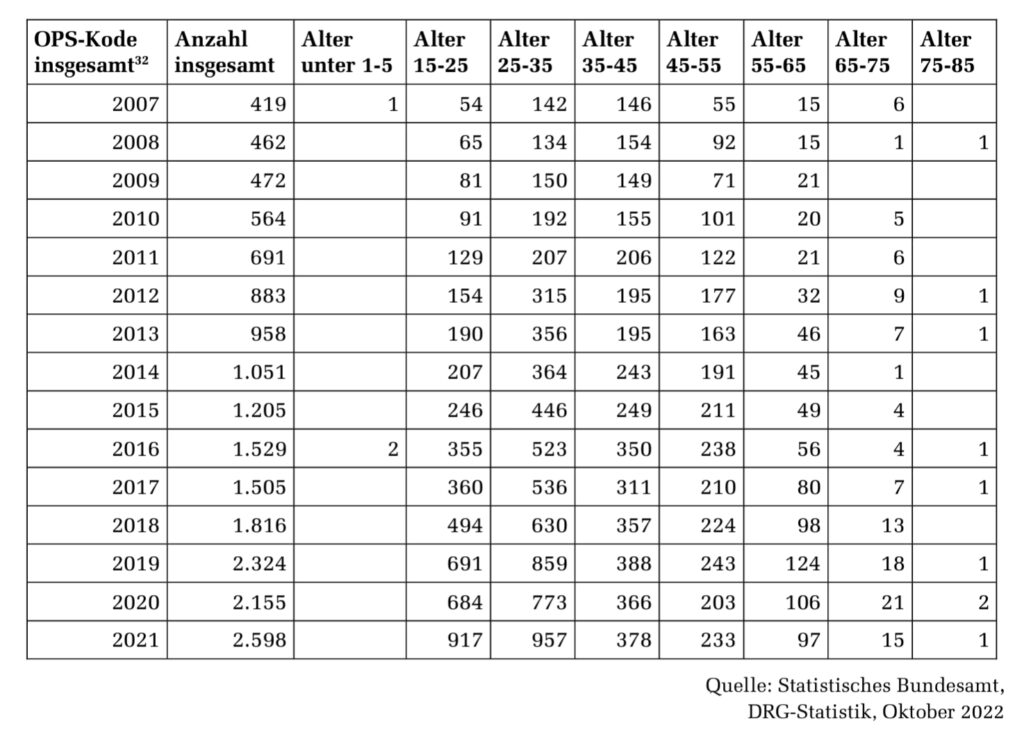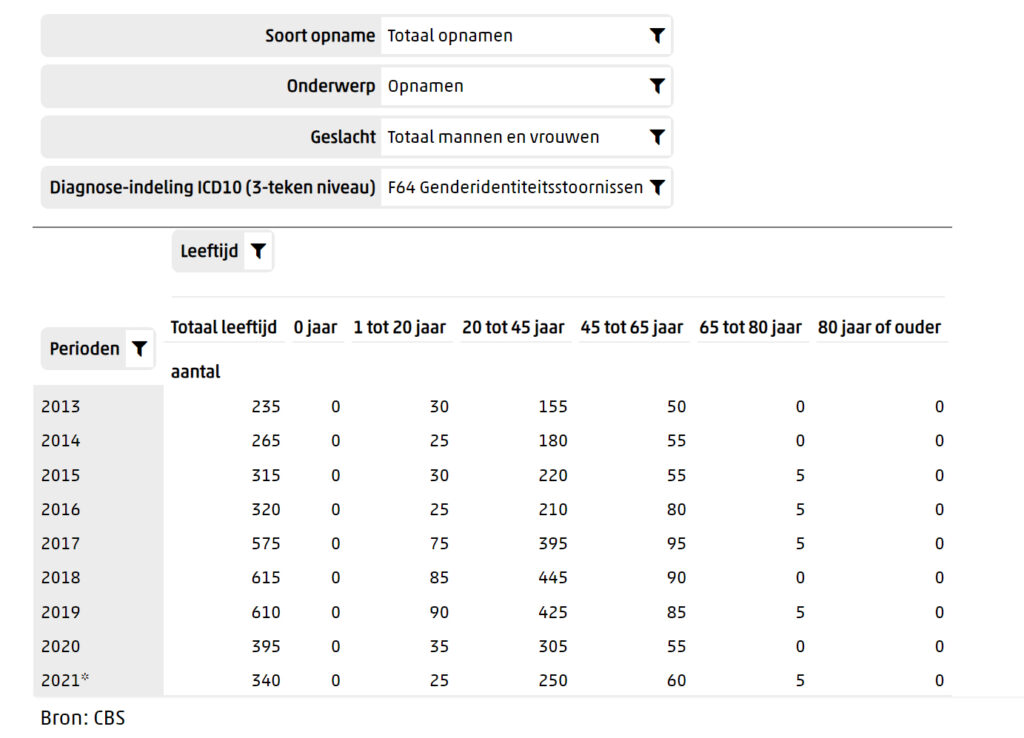In the documentary “Trans is a Trend: How an Ideology is Changing Our Country”, published on the German news website NIUS.de, authors Judith Sevinc Basad and Jan A. Karon claim that gender-affirming surgeries in Germany have increased from 120 in 2005 to 2.598 in 2021. They also argue that being trans is a dangerous trend among many young people. After conducting the research, it was concluded that this claim is mostly false because of the incorrect framing.

Has the number of gender-affirming surgeries increased in Germany?
The Federal Statistical Office of Germany (Statistisches Bundesamt) has annually published, since 2005, the number of people who underwent gender-affirming surgery. By examining the statistics, the increase noted in the documentary from 120 surgeries in 2005 to 2,598 in 2021 can indeed be verified. It’s important to note that the figures represent the number of operations and procedures performed, not the number of cases. Multiple operations and procedures per patient are possible.

Is the increase more noticeable among younger people compared to older age groups?
According to the documentary, transgender identity has especially become increasingly popular among young people. To determine if there’s a more significant rise over the years among younger age groups compared to older ones, the statistics were examined again. Indeed, there’s a notable increase in gender-affirming surgery among younger individuals, particularly those aged 15 to 35, while there’s a decrease in such procedures among those aged 55 to 85. It’s important to note that in Germany, as well as in other EU countries like the Netherlands or Austria, gender-affirming surgeries for individuals under 18 years old are rare. When minors do undergo surgery, it typically involves mastectomies, as genital surgeries are not performed on this age group.

What are the reasons for the increase?
To shed light on the factors driving this upward trend, we consulted Robin Ivy Osterkamp from the Queer Network of Lower Saxony. Osterkamp is responsible for overseeing all matters related to transgender and nonbinarity within the organization. Osterkamp emphasized the societal shift towards greater acceptance as a key factor. Osterkamp pointed out legal changes, such as those in the Transsexual Act (TSG), prompting a significant increase of people changing their civil status, following the 2011 ruling by the Constitutional Court, which removed the requirement for proof of infertility. According to Osterkamp, this example illustrates that as society becomes more liberal and access to resources improves, people are more likely to utilize them.
Additionally, Osterkamp suggests that the growing number of gender-affirming surgeries may also be attributed to a heightened sense of safety surrounding these procedures. Osterkamp notes that while surgeries like mastectomy are relatively less invasive, genital-affirming surgeries can significantly impact quality of life, particularly in areas such as urination and sexual function. Osterkamp speculates that improved surgical techniques, better outcomes, and increased confidence in the healthcare system and the expertise of medical professionals performing these procedures may also contribute to the rising trend, beyond simply an increase in individuals identifying as transgender.
What is the reason for the decrease among older people?
Robin Ivy Osterkamp also elaborated on the challenges faced by those who transition later in life. Osterkamp emphasizes that especially for transfeminine individuals, that transition later in life, the prolonged effects of testosterone on the body pose considerable hurdles. As time passes, it becomes increasingly difficult to counteract these effects effectively with estrogen and hormone blockers. Attaining a convincingly feminine appearance becomes more demanding with age, which makes opting for an early transition more appealing for many individuals.
Is a general increase of people identifying as transgender observed in EU countries?
Data from the Netherlands and Germany were compared concerning individuals diagnosed under the code “F64.0: Transsexualism” in the 10th revision of the International Statistical Classification of Diseases and Related Health Problems (ICD-10), a medical classification list maintained by the World Health Organization (WHO). It should be noted that the diagnosis “Transsexualism” is no longer considered a mental disorder in the ICD-11, which took effect on January 1, 2022. Instead, it’s now categorized as “gender incongruence”. In the Netherlands, data shows an increase in diagnoses from 235 in 2013 to a peak of 615 in 2018, before decreasing to 340 in 2021.

The statistics from Germany also show a noticeable rise from 2013 to 2021, with diagnoses increasing from 974 in 2013 to 1999 in 2021. There was a consistent uptrend in diagnoses from 2013 to 2019, but then a decline occurred in 2020.

Do many people regret undergoing gender-affirming surgery and what are the most common reasons for detransitioning?
An aspect that is also brought up in the documentary along with trans being just a trend is that many people later regret undergoing surgery. In the S3 guideline for the diagnosis, counseling, and treatment of gender incongruence, gender dysphoria, and trans health, the frequency of detransition where body-modifying treatments have already been carried out is assessed as very low according to the available studies. The estimate ranges from less than one percent to 3.8 percent. Robin Ivy Osterkamp and Paul H., a trans man that we also interviewed, both point out that the primary reason for detransitioning is often the lack of a supportive environment. When individuals don’t feel accepted and find themselves constantly defending their transgender identity, it can become overwhelming. This ongoing struggle can prevent them from finding peace and stability in their lives. In such situations, individuals may weigh the challenges they face against the benefits of detransitioning, ultimately deciding to revert to their previous gender presentation.
Can being trans be considered a dangerous trend or even an ideology?
In a publication from Bundesverband Trans, a nationwide special interest group advocating for transgender rights, the authors address precisely these questions. They argue that diverse gender identities have always existed. While some societies respected this diversity until colonialism, many others, including Germany, suppressed and disregarded it for centuries. Recently, these societies have become more open and accepting toward transgender people, leading to more individuals coming out as trans. The authors state that a trans-friendly society doesn’t create more trans individuals but instead encourages more people to be open about their identity or consider transitioning. Considering these points, it cannot be viewed as a dangerous trend that has emerged only recently.
The authors also point out that “gender ideology” is a term mainly used by right-wing groups to oppose transgender rights, gender equality, and sexual/reproductive rights. It’s used to discredit these concerns by associating them with negative ideas of artificiality and manipulation.
The video summarises the fact check
Conclusion
In short, while the numbers are accurate, several reasons suggest that this increase is not due to being trans becoming a trend. Instead, it is attributed to improved medical care for trans people and a more open society. Therefore, this claim can be rated as mostly false.
RESEARCH | ARTICLE © Joanne Mott and Selina Schräder, Jade Univefsity of Applied Sciences Wilhelmshaven, Germany
Leave your comments, thoughts and suggestions in the box below. Take note: your response is moderated.





